Soldiers & Sailors Monument
Introduction
Text-to-speech Audio
The Soldiers and Sailors Monument, situated at One Monument Circle in downtown Indianapolis, was dedicated on May 15, 1902. The monument was designed to honor the common soldier and was constructed over a thirteen-year period between 1888 and 1901. The structure is the largest outdoor memorial in the state of Indiana and has become closely tied to the identity of both the state and the city of Indianapolis. The Soldiers and Sailors Monument once housed the Colonel Eli Lilly Civil War Museum until flooding led to the relocation of those artifacts to the Indiana War Memorial. The monument was added to the National Register of Historic Places on February 13, 1973.
Images
Soldiers & Sailors Monument
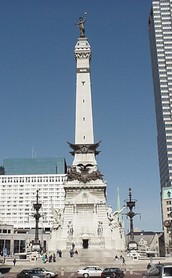
Colonel Eli Lilly Civil War Museum
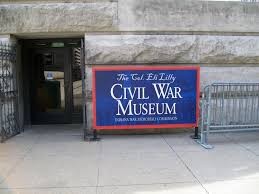
Soldiers & Sailors Monument

Soldiers & Sailors Monument, 1907
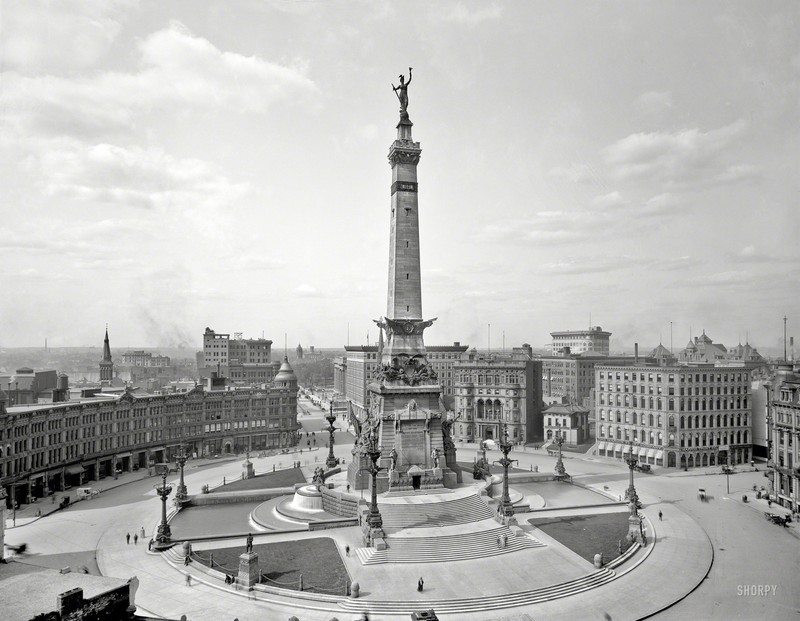
1888 rendering of the monument from STONE magazine
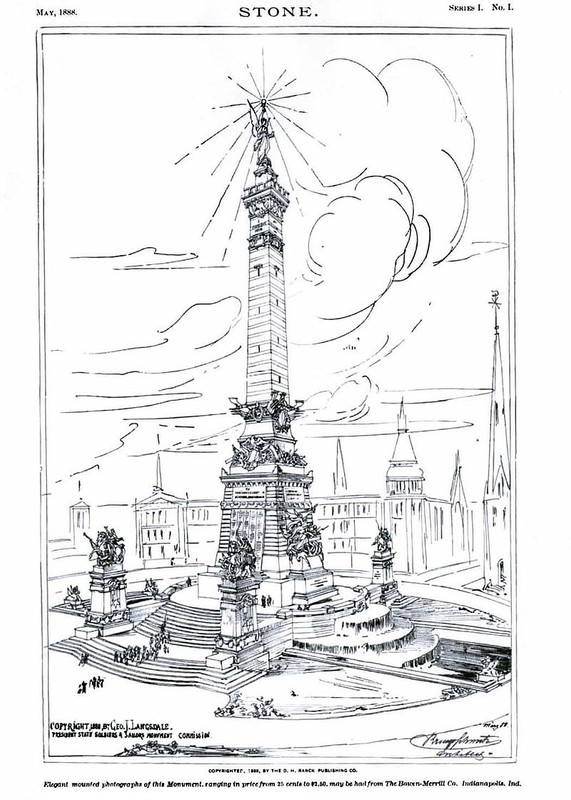
The Soldiers' and Sailors' Monument in Indianapolis about 1898. Historic American Buildings Survey PHOTOCOPY: EXTERIOR, SOUTH ELEVATION, c. 1898 HABS, IND,49-IND,16-3 Number three in a series of 15 photos of the Soldiers' and Sailors' Monument, Indianapo

Colonel Ely Lily in 1885
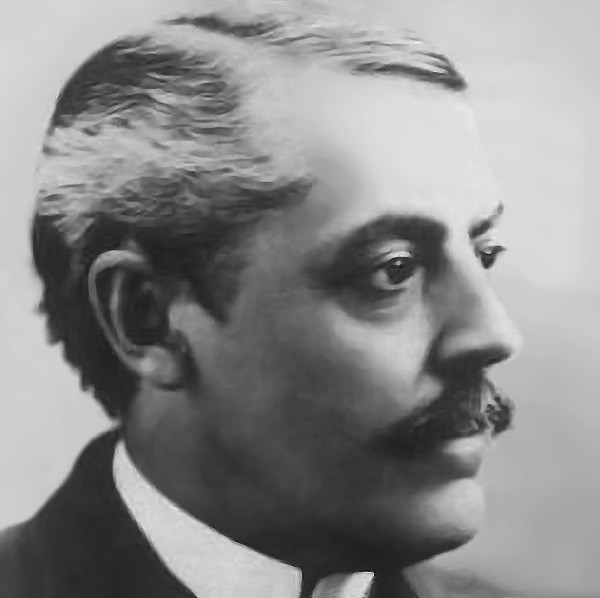
Backstory and Context
Text-to-speech Audio
For the first twenty years of the monument's existence, city ordinance prohibited the construction of any building near the monument that exceeded it in height. That ordinance came under fire from downtown promoters and was modified in 1922 to allow buildings to be taller so long as they did not overshadow the monument. For example, the Circle Tower uses a tiered design, with higher stories backing away from the building facade that faces the monument.
The monument was designed by German architect Bruno Schmitz and was intended to honor Indiana's American Civil War veterans. However, the design also pays tribute to those who served in the American Revolutionary War and a number of territorial conflicts including the Mexican and Spanish American Wars.
Many times after the Civil War suggestions were made to build a monument honoring Indiana's Civil War veterans. The first proposal was made on April 1, 1862, when an anonymous editorial in the Indianapolis Daily Journal suggested a monument be erected in Circle Park; however, no action was taken. Talk of a monument continued in the years following the war. In 1867 governor Morton suggested a monument be erected on the highest point in Crown Hill Cemetery, but nothing came of it. In 1872 William H. English addressed a group of Civil War veterans and expressed his support for a monument at Crown Hill, but a bill introduced in the state legislature failed to pass. Other potential sites for the monument included University Park, Military Park, and the corner of Washington and Illinois streets in the city's downtown business district, along the National Road.
No progress on was made on the monument until August 1875, when George J. Langsdale, a newspaper editor of the Greencastle Banner, presented a plan for a memorial during the first reunion of Civil War veterans, which was held in Indianapolis. Langsdale's idea was favorably received and a monument association was formed. By 1887 the Indiana Department of the Grand Army of the Republic had raised $23,380, before relinquishing responsibility for the monument to the State of Indiana.
Further action was taken on March 3, 1887, when the Indiana General Assembly passed a bill to form a monument commission, whose original members included Samuel B. Voyles, D. C. McCollum, Daniel M. Ransdell, George J. Johnson, James, G. Gookins, and Langsdale, who was elected the committee's president at its first meeting on June 28, 1887. Randsell, who resigned two years later, was replaced by Thomas W. Bennett, and William H. English replaced Bennett. Other commissioners included General Mahlon D. Manson, and Thomas A. Morris. The bill also authorized the monument to be built in Indianapolis and appropriated $200,000 for the project. Some state legislators disagreed over use of the Circle as the monument's site; however, the legislative act that authorized it specifically identified the intended site as Circle Park.
To select a design for the new monument, the commission established an international contest and solicited ten architects to submit sketches. Notices were also placed in leading newspapers in the United States, Canada, England, France, Germany, and Italy, to encourage others to submit their ideas. The contest deadline was set for January 12, 1888, and seventy designs were submitted. The selection committee, who initially did not know the identity of the designers, chose two entries for further consideration. Bruno Schmitz, an architect from Berlin, Prussia, who submitted a design called Symbol of Indiana was the commissioners' unanimous choice as the winner. Schmitz, an architect knowledgeable in the field of monument design, was also a friend and fellow artist of the commission's secretary, James F. Gookins, when the two lived in Munich, Germany. Percy Stone, of London, England, received $500 for his second-prize entry.
Several individuals and companies were involved in the monument's construction. Schmitz received his commission as the project's supervising architect in February 1888. His contract for the project specified his commission as five percent of the monument's total cost.[20] Schmitz arrived in Indianapolis from Germany in January 1889. Frederick Bauman, of Chicago, was appointed the project's deputy architect and Schmitz's representative. Enos Hege, of Indianapolis, received the contract to erect the monument's foundation, which was completed in 1888, and Thomas McIntosh, of Greencastle, Indiana, and an expert in stonework, became the project's superintendent. The Terre Haute Stone Works Company was awarded the contract to construct the monument's terraces, approaches, and superstructure. The project's stone and bronze sculptors included Rudolph Schwarz, Nikolaus (or Nicolaus) Geiger, George Brewster, and John Mahoney. Although ambiguous language in the authorizing bill created some confusion over the type of memorial to be erected, either a single monument or a combination of monument and memorial hall, the controversy was cleared up in 1893, six years after the bill's initial passage, when its confusing statement was repealed. In the meantime, construction continued using Schmitz's design.
The cornerstone was laid on August 22, 1889. Inside, a copper box contained, among other items, an official list of all Indiana soldiers who had served in the Civil War, newspapers, copies of Indiana's two constitutions, a thirty-eight-star American flag, a photograph of Schmitz, the ceremony's program, and other related paraphernalia from the Grand Army of the Republic, the Women's Relief Corps, the Sons of the Republic, and other groups. Ceremonies held on the northeast corner of the monument included a speech by President Benjamin Harrison, an artillery salute, and a parade. Members of Harrison's cabinet, Indiana's governor Alvin P. Hovey, and other state officials were present. The Department Commander of the Grand Army of the Republic was master of ceremonies. It was the first monument in the United States to be dedicated to the common soldier.
Public donations and the Indiana General Assembly's initial appropriations were not sufficient to fund the complete project. More funds were required. The state legislature appropriated an additional $160,000, and in 1891, raised over $123,000 with an additional property tax. Construction on the monument, which began in 1888, took thirteen years to complete. The obelisk was completed in 1892, the main elements by 1894, and its final installations in 1901. In 1893 the circle was renamed Monument Place. The cost to complete the monument was $598,318. An estimate to erect a similar structure in 2014 suggests it would exceed $500 million.
The monument was formally dedicated on May 15, 1902. Thousands came to the public event, which began at 8 a.m. with a parade of flags and veterans of the Mexican-American, Civil, and Spanish–American Wars, and ended with an evening fireworks display. The formal dedication ceremony was held at 10 a.m. with General Lew Wallace as the master of ceremonies. General David R. Lucas led the gathering in prayer, and Governor Winfield T. Durbin, Wallace, and John W. Foster, the former United States Secretary of State under President Benjamin Harrison, gave speeches. A male chorus sang and poet James Whitcomb Riley read his poem "The Soldier", which was written especially for the occasion. Musicians played John Philip Sousa's "The Messiah of the Nations", a march he had composed for the occasion. Following a second parade in the afternoon and an evening vesper service, the bells of Christ Church sounded and its choir sang "My Country, 'Tis of Thee."
In the years since its public dedication on May 15, 1902, the monument has become an iconic symbol of Indianapolis. It is the first monument in the United States to be dedicated to the common soldier, and the largest outdoor memorial and the largest of its kind in Indiana. The monument was included in the National Register of Historic Places on February 13, 1973. In 2011, the American Planning Association recognized Monument Circle as one of the nation's "great public spaces" in its annual "Great Places in America" ranking. The minor league Indy Eleven soccer team features Victory prominently in their logo.
Sources
Soldiers and Sailors Monument. Indiana War Memorial Commission. Accessed February 17, 2017. http://www.in.gov/iwm/2335.htm.
Fadely, James Philip (Winter 2006). "The Veteran and the Memorial: George J. Gangsdale and the Soldiers and Sailors Monument". Traces of Indiana and Midwestern History. Indianapolis: Indiana Historical Society. 18 (1): 33–35.
Greiff, Glory-June (2005). Remembrance, Faith, and Fancy: Outdoor Public Sculpture in Indiana. Indianapolis: Indiana Historical Society.
Hyman, Max R., ed. (1902). The Journal Handbook of Indianapolis: An Outline History. Indianapolis, Ind.: The Indianapolis Journal Newspaper Company.
Rose, Ernestine Bradford (1971). The Circle: The Center of Indianapolis. Indianapolis: Crippin Printing Corporation.
"Colonel Eli Lilly (1838-1898)" (pdf). Lilly Archives. January 2008.
Madison, James H (1989). Eli Lilly: A Life, 1885–1977. Indianapolis: Indiana Historical Society.
Kahn, E. J. (1975). All In A Century: The First 100 Years of Eli Lilly and Company. West Cornwall, CT.
